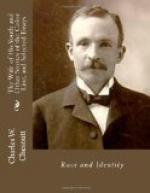There are three tribunals to which the colored people may justly appeal for the protection of their rights: the United States Courts, Congress and public opinion. At present all three seem mainly indifferent to any question of human rights under the Constitution. Indeed, Congress and the Courts merely follow public opinion, seldom lead it. Congress never enacts a measure which is believed to oppose public opinion;—your Congressman keeps his ear to the ground. The high, serene atmosphere of the Courts is not impervious to its voice; they rarely enforce a law contrary to public opinion, even the Supreme Court being able, as Charles Sumner once put it, to find a reason for every decision it may wish to render; or, as experience has shown, a method to evade any question which it cannot decently decide in accordance with public opinion. The art of straddling is not confined to the political arena. The Southern situation has been well described by a colored editor in Richmond: “When we seek relief at the hands of Congress, we are informed that our plea involves a legal question, and we are referred to the Courts. When we appeal to the Courts, we are gravely told that the question is a political one, and that we must go to Congress. When Congress enacts remedial legislation, our enemies take it to the Supreme Court, which promptly declares it unconstitutional.” The Negro might chase his rights round and round this circle until the end of time, without finding any relief.
Yet the Constitution is clear and unequivocal in its terms, and no Supreme Court can indefinitely continue to construe it as meaning anything but what it says. This Court should be bombarded with suits until it makes some definite pronouncement, one way or the other, on the broad question of the constitutionality of the disfranchising Constitutions of the Southern States. The Negro and his friends will then have a clean-cut issue to take to the forum of public opinion, and a distinct ground upon which to demand legislation for the enforcement of the Federal Constitution. The case from Alabama was carried to the Supreme Court expressly to determine the constitutionality of the Alabama Constitution. The Court declared itself without jurisdiction, and in the same breath went into the merits of the case far enough to deny relief, without passing upon the real issue. Had it said, as it might with absolute justice and perfect propriety, that the Alabama Constitution is a bold and impudent violation of the Fifteenth Amendment, the purpose of the lawsuit would have been accomplished and a righteous cause vastly strengthened. But public opinion cannot remain permanently indifferent to so vital a question. The agitation is already on. It is at present largely academic, but is slowly and resistlessly, forcing itself into politics, which is the medium through which republics settle such questions. It cannot much longer be contemptuously or indifferently elbowed aside. The South itself




